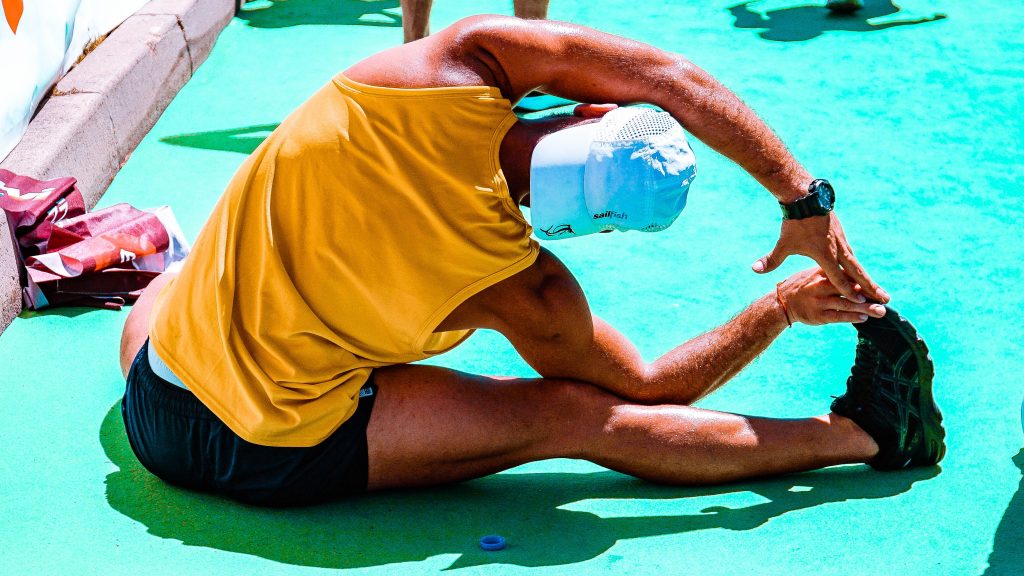There is no argument that exercising is great for our bodies. However, sometimes we can injure ourselves in the process. Exercise injuries can be avoided by taking a series of safety measures, one of which is doing the right stretching exercises. In this article, we are going over different types of stretching, with a focus on active isolated stretching.
Types of stretching

Stretching is one of the essentials of a healthy exercise routine. However, it eludes many of us due to a lack of information about its importance. There are different types of stretching that can benefit your body greatly. Let’s review them briefly.
Static stretching
It’s the most common type of stretching. It’s when you extend the target muscle group as much as you can and hold it for a short period of time. Static stretches increase your range of motion (ROM), relieve musculotendinous stiffness, and reduce the risk of muscle strains. It includes 2 subtypes:
Active stretching: Active stretches are when you apply the force to the muscle group by yourself. Active stretching can reduce pain, improve circulation, improve athletic performance and strengthen muscle groups.
Passive stretching: Passive stretches are when you use an external force applied by a partner or exercise tool such as an exercise band. Passive stretching can improve flexibility, range of motion, and mobility. Doing Passive stretching lowers the risk of injury since you get help from an object or a fitness professional.
Dynamic stretching
As opposed to the previous type, dynamic stretching is done while constantly moving. It aims to prepare you for a specific sport by emphasizing stretching the muscles you use to do that sport. Dynamic stretching improves speed, agility, and acceleration.
Ballistic stretching
In this type of stretching, you add repeated bouncing movements to your stretching. It’s usually used in athletic drills. Ballistic stretching pushes your muscles through a range of motions and improves flexibility.
Myofascial release
Fascia is a thin layer that covers and holds all the organs, bones, vessels, and muscles in the body. They’re the connective tissues that hold your body together. My fascial stretching helps relieve tension on the fascia and makes it more flexible by doing continuous back and forth movements.
Proprioceptive Neuromuscular Facilitation (PNF)
It aims to improve your range of motion, especially after an injury or surgery. It’s usually done with the supervision of a trainer.
Active Isolated Stretching
Finally, what you’re here for, AIS is the type of stretching exercise that stretches a specific target muscle group while contracting the opposite muscle group. It aims to prepare the body for physical activities within your range of movement. The risk of injury in AIS is very low.
How is Active Isolate Stretching done?
AIS is a four-step process that includes:
- Targeting and isolating the muscle group
- Stretching the targeted muscle group while contracting the opposite one
- Holding the stretch for no more than 2 seconds
- Repeating this move several times
What are the benefits of AIS?
Active stretching contributes to increasing muscle length, according to a study published in PubMed. Holding the stretch for a maximum of 2 seconds maximum avoids the activation of the stretch reflex. Stretch reflex (or myotatic reflex) prevents stretching a muscle too far or too fast. When you deactivate this reflex, you push the target muscle to increase the range of motion and flexibility.
AIS is good for general fitness and rehabilitation. It can be a good warm-up before doing any physical activity. It’s also a great way to gradually regain strength after an injury and delay muscle atrophy.
AIS can benefit all groups, but it’s specifically good for people who suffer from the following conditions.
Arthritis
AIS decreases the pain and swelling caused by arthritis.
Multiple Sclerosis
AIS relieves the stiffness caused by MS.
Plantar Fasciitis
This condition signifies inflammation in the tissue that connects the toe to the heel. AIS relieves the pain caused by Plantar Fasciitis.
Sciatica
Pain caused by sciatica can be decreased by doing AIS that focuses on gluteal muscles, hamstrings, and piriformis muscles.
Some common AIS exercises to improve your muscles
Here are some great active stretching exercises that you can do to contribute to your muscular length and range of movement.
Supine hamstring stretch
Lie back on the floor, extend your legs toward the ceiling, and bend your knees slightly. Flex your toes, contract your quadriceps and lower one of your legs close to the floor. Once you feel a stretch in the opposite hamstring, stop and hold in this position for a couple of seconds and raise your leg back up. Repeat six times for each leg.
Lunge hip flexor stretching
Get a step or box the same height as your knees. Stand in front of it and put one foot on top. Contract the glutes, lean forward, and transfer your weight to the front leg. Hold in this position for a couple of seconds before returning to the starting position. Repeat the stretch ten times for each leg. You can do this exercise without a step by kneeling down.
Lateral trunk flex
Stand up straight. Put both hands behind your head and hold your elbows pointed away from the body. Bend at the waist to your side until you feel a good stretch on the opposite side. Hold for 2 sends and come back up. Repeat ten times and move on to the opposite side.
Final Words
It is important to do a wide range of stretching exercises based on your physical conditions and needs. Active isolate stretching can benefit everyone, whether they are trying to be more flexible, heal from injuries, or prepare for more intense physical activities.
